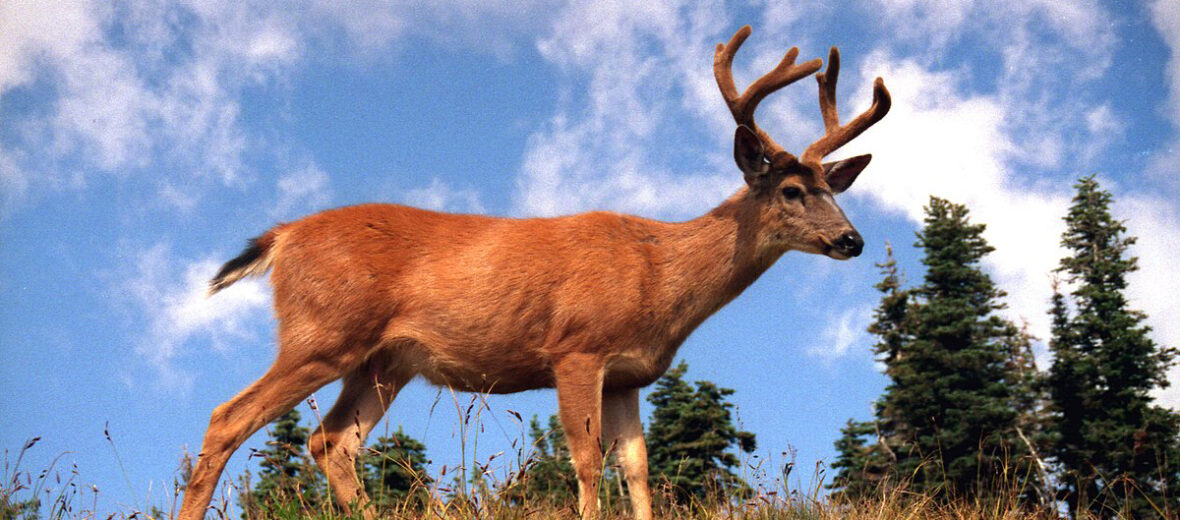
The black-tailed deer is a subspecies of mule deer. They can be found in Alaska, Canada, through many of the main U.S. states (from the midwest to the Pacific west), down into Mexico, and Baja California. They prefer forest edges as the further they venture into the main forested habitats the less grazing opportunities there are. Even though these deer face the threats of habitat loss and destruction at the hands of residential and commercial development, farming, ranching, and other ecosystem modifications; hunting; trapping; and invasive species (and with them disease and competition for food), these deer are abundant, with a stable population, and are thus listed as Least Concern by the IUCN.
First the Stats…
Scientific name: Odocoileus hemionus columbianus
Weight: Up to 330 lbs.
Length: Up to 5 feet
Height: Up to 3.28 feet, at the shoulders
Lifespan: Up to 20 years
Now on to the Facts!
1.) Unfortunately, black-tailed deer are a popular big game animal for hunters.
2.) These deer are crepuscular (active at dawn and dusk).
3.) Sadly, these deer tend to stray close to roads and are thus often subjected to vehicle strike (being hit by vehicles).
4.) Being browsers, these deer graze on red huckleberry, salal, deer fern, Douglas fir, western red cedar, and lichens growing on trees in winter and early spring. In late spring to fall they switch to apples, blackberries, grasses, fireweed, pearly everlasting, forbs, salmonberry, salal, and maple.
5.) Antlers are regrown starting in April – August.
But wait, there’s more on the black-tailed deer!
6.) Shed antlers provide a calcium rich food source for certain forest creatures. Rodents, opossums, bears, foxes, and otters all chew on the antlers to obtain calcium. This is called osteophagy (consumption of bone).
7.) Mating season, aka rutting season, occurs from November to early December.
Did you know…?
A popular food for these deer is poison oak.
8.) During mating season, the chance of vehicle strike is greatly increased as bucks will often chase does across roads in an attempt to breed with them.
9.) After the rutt, bucks will drop their antlers. This takes place between January – March.
10.) Does undergo up to a 7 month gestation (pregnancy) that yields up to 2 twin fawns.
But wait, there’s still more on the black-tailed deer!
11.) For up to the first week or 2 fawns have no scent. This is an evolutionary adaptation to aid in avoiding predators.
12.) Even with superb care by the doe, the mortality rate for fawns is up to a staggering 70%.
Did you know…?
Like other North American ungulates, black-tailed deer are subject to infection from chronic wasting disease (CWD), aka zombie deer disease. CWD is a prion disease, which is caused by a malformed protein that builds up in the brain and other tissues. It causes neurological symptoms, emaciation, and eventual death.
13.) The doe becomes very defensive towards would-be predators, and protective of her fawns even against humans.
14.) Deer produce different scents from glands in their forelimbs and hindlimbs.
15.) Black bears, coyotes, mountain lions, wolves, bobcats, and brown bears all prey on these deer.
Now a Short Black-Tailed Deer Video!
Be sure to share & comment below! Also, check out the Critter Science YouTube channel. Videos added regularly!
Want to suggest a critter for me to write about? Let me know here.
Some source material acquired from: Wikipedia & IUCN
Photo credit: Benjamin Zingg



